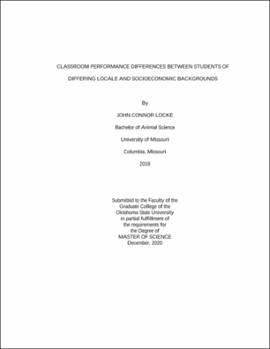| dc.contributor.advisor | French, Donald P. | |
| dc.contributor.author | Locke, John Connor | |
| dc.date.accessioned | 2021-05-25T20:42:23Z | |
| dc.date.available | 2021-05-25T20:42:23Z | |
| dc.date.issued | 2020-12 | |
| dc.identifier.uri | https://hdl.handle.net/11244/329965 | |
| dc.description.abstract | Institutions are interested in the academic performance of students of different demographics, because academic performance plays a role in their persistence and graduation. Race/Ethnicity and socioeconomic status are established as predictors of student performance, with minority students and students of lower socioeconomic status performing at lower levels than majority students and those of higher socioeconomic status. One demographic that has been overlooked has been locale, i.e. from where along the rural to urban spectrum a student originates. Rural areas tend to lack the resources available in more urbanized areas, due to issues stemming from higher rates of poverty and distance from resources. This study seeks to answer three questions: 1) Is there any overall (main) effect of locale on student performance; 2) Do two-way interactions exist between locale and Community, Socioeconomic Status (CSES) or locale and race/ethnicity; and 3) Can differences in performance be attributed to an interaction between locales, race/ethnicity, and community socioeconomic status. This study used data recorded at a south central, high-research, land grant institution between 2006 and 2019 and the National Center for Education Statistics' (NCES) publically accessible Common Core of Data to test for differences in mean student grade in gatekeeper science and math courses among students of different race/ethnicity, CSES ( as determined by the percentage of students enrolled in free or reduced lunch programs), and locale ( as determined by the NCES locale designation of the students' high schools). The courses were evaluated independently using three-way ANOVA to determine if main and interaction effects were present among or between the demographics. Duncan's Multiple Range Tests to examine differences among the levels of each variable. Significant differences among mean student grade were found for race/ethnicity and CSES for most courses, and only in one course for locale. No two-way or three-way interactions were found for any course. These result do not support the use of locale as an indicator of the need for additional support or intervention at this institution. Efforts to increase student performance should remain focused on poorer schools and those with high levels of disaffected minority students, regardless of locale. | |
| dc.format | application/pdf | |
| dc.language | en_US | |
| dc.rights | Copyright is held by the author who has granted the Oklahoma State University Library the non-exclusive right to share this material in its institutional repository. Contact Digital Library Services at lib-dls@okstate.edu or 405-744-9161 for the permission policy on the use, reproduction or distribution of this material. | |
| dc.title | Classroom performance differences between students of differing locale and socioeconomic backgrounds | |
| dc.contributor.committeeMember | Angle, Julie | |
| dc.contributor.committeeMember | Bruck, Jason | |
| osu.filename | Locke_okstate_0664M_16993.pdf | |
| osu.accesstype | Open Access | |
| dc.type.genre | Thesis | |
| dc.type.material | Text | |
| dc.subject.keywords | locale | |
| dc.subject.keywords | race/ethnicity | |
| dc.subject.keywords | rural | |
| dc.subject.keywords | socioeconomic status | |
| dc.subject.keywords | student performance | |
| dc.subject.keywords | urban | |
| thesis.degree.discipline | Education | |
| thesis.degree.grantor | Oklahoma State University | |
